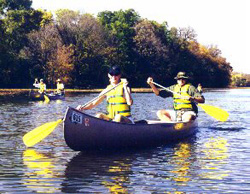If you drive in the Chicago metropolitan region, you’re probably more familiar than you’d like to be with the intricate highway system that covers the landscape.
But are you aware that, often just a few hundred feet away from these roads, there’s an entirely different transportation network? Five hundred miles of quiet tranquility and natural beauty, shared with the likes of great blue herons rather than semi-trailer trucks?
“Many motorists in Northeast Illinois,” says Gary Mechanic, “don’t realize that the river they go over at Great America and the one they go over at Romeoville are the same river.”
 That river is the DesPlaines River, one of the 10 waterways that make up the Chicago region’s 500-mile water trail system. The others are the Chicago River, Nippersink Creek, the Kishwaukee River, Salt Creek, the DuPage River, the Fox River, the Little Calumet River, the Kankakee River and Lake Michigan.
That river is the DesPlaines River, one of the 10 waterways that make up the Chicago region’s 500-mile water trail system. The others are the Chicago River, Nippersink Creek, the Kishwaukee River, Salt Creek, the DuPage River, the Fox River, the Little Calumet River, the Kankakee River and Lake Michigan.
Mechanic, the vice president of the Illinois Paddling Council, has been working for more than a decade to improve and promote that water trail system for use by canoeists and kayakers.
In 1999, he and the paddling council helped draft the Northeastern Illinois Regional Water Trails Plan which has been used to coordinate efforts at making these waterways more available to hard-core and weekend paddlers alike. Also involved in creating the plan were Openlands, a non-profit conservation group, and the Northeastern Illinois Planning Commission, recently replaced by the Chicago Metropolitan Agency for Planning.
Since then, dozens of new launch and portage sites have been added to the system as well as improved signage and promotion. “Slowly, like the Chicago River Plan or any other major regional plan,” Mechanic says, “improvements come into existence over a long period of time.”
Sort of like Daniel Burnham’s 1909 Plan of Chicago.
Celebrations Saturday and Sunday
This weekend, as part of the 100th anniversary of the publication of the Burnham Plan, two events will celebrate the regional water trail system:
+ On Saturday, shortly after 8:30 a.m., dozens of paddlers will launch from Northerly Island (at 12th Street and the lakefront) for the start of a two-day Chicago-to-Michigan City, Ind., expedition. The trip will stop at nine locations, including Calumet Park in the South Chicago neighborhood and such Indiana cities as East Chicago and Gary, and conclude at 5:30 p.m. Sunday at Millennium Plaza at Washington Park in Michigan City.
+ On Sunday, from 10 a.m. to 2 p.m., Openlands will highlight the Chicago-region water trails, particularly the new launch sites along the Little Calumet River, with a host of activities at Gouwens Park near 16127 Seton Dr. in South Holland. Among the offerings: guided trips, canoe rentals and safety demonstrations.
The two events highlight a growing regional sensibility.
The water trail system has become more accessible over the past decade through the efforts of conservationists, paddlers and officials on all levels of government throughout the seven-county region.
“You really can paddle just about every one of the 500 miles and be able to get out at just about every place and not have to be a great athlete,” Mechanic says.
Laura Barghausen of Openlands notes that, of 164 recommended launch sites identified in the 1999 plan, 105 are now established, and another 29 are unimproved but available for use. Of the remaining 30, applications for funding are already pending on five.
“The truth about the water trail system," she says, "is that it’ll keep improving probably forever.”
The Chicago-to-Michigan City expedition, spearheaded by the Northwest Indiana Paddling Association and its Illinois counterpart, is the inauguration of a new Southern Lake Michigan Water Trail. This route, for the first time, links Chicago’s Lake Michigan trail with a water path across much of the northern shoreline of Indiana.
Eliminating lines
As Mechanic points out, a waterway can’t help but be regional. “By its nature, [a canoe trip] is the kind of journey that forces people to ignore the invisible county lines they pass,” he says.
And city lines? And township lines? And state lines?
“All of that.”
.jpg) Indeed, paddling along a river crosses time-lines as well. “Riding on the North Branch of the Chicago River, with the tree canopy overhead, if it wasn’t for the jets going overhead, you’d never know you were in a city,” Mechanic says.
Indeed, paddling along a river crosses time-lines as well. “Riding on the North Branch of the Chicago River, with the tree canopy overhead, if it wasn’t for the jets going overhead, you’d never know you were in a city,” Mechanic says.
Or in the year 2009.
“These are our ancient trails,” he says. “We don’t have mountains or islands in the lake. These are our ancient areas.”
For a print-friendly version of this post, go here.
Blog Categories
- art (14)
- civic engagement (17)
- culture (16)
- future (26)
- green legacy (15)
- history (26)
- pavilions (4)
- schools (8)
- transportation (7)
